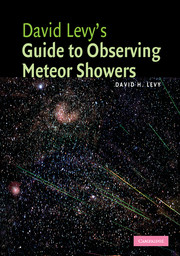Book contents
- Frontmatter
- Contents
- Preface
- 1 July 4, 1956
- 2 What is a meteor?
- 3 Some historical notes
- 4 Small rocks and dust in space
- 5 Observing meteors
- 6 Recording meteors
- 7 A New Year gift: the Quadrantids
- 8 The Lyrids – an April shower
- 9 The Eta Aquarids
- 10 The Omicron Draconids, continued
- 11 The Delta Aquarids
- 12 Tears of St. Lawrence: Perseid trails and trials
- 13 The August Pavonids
- 14 The Orionids
- 15 The Taurids
- 16 The Leonids
- 17 The Geminids
- 18 The Ursids
- 19 A catalog of meteor showers throughout the year
- Appendix
- Index
12 - Tears of St. Lawrence: Perseid trails and trials
Published online by Cambridge University Press: 06 July 2010
- Frontmatter
- Contents
- Preface
- 1 July 4, 1956
- 2 What is a meteor?
- 3 Some historical notes
- 4 Small rocks and dust in space
- 5 Observing meteors
- 6 Recording meteors
- 7 A New Year gift: the Quadrantids
- 8 The Lyrids – an April shower
- 9 The Eta Aquarids
- 10 The Omicron Draconids, continued
- 11 The Delta Aquarids
- 12 Tears of St. Lawrence: Perseid trails and trials
- 13 The August Pavonids
- 14 The Orionids
- 15 The Taurids
- 16 The Leonids
- 17 The Geminids
- 18 The Ursids
- 19 A catalog of meteor showers throughout the year
- Appendix
- Index
Summary
It's a Colorado Rocky Mountain high
I've seen it rainin' fire in the sky
Friends around the campfire and everybody's high
Rocky Mountain High.
Marathon, NY (see Figure 12.1), on the night of July 15, 1862, was a sleepy town under an incredibly dark sky. Located in Cortland county in the northwestern part of New York, the rolling hills offered peace and quiet, and starry nights. The area has grown much since that night: seven years later a major educational institution was founded in nearby Cortland. Now called the State University of New York at Cortland, the University does much to enrich an area already famous for academic pursuits and scholarship. Meanwhile, Marathon, at some distance from the county's center, still offers a sky almost as dark as it was that July night 150 years ago, when Lewis Swift turned his 4 1/2-inch diameter refractor toward the constellation of Camelopardalis, the giraffe, and discovered a comet.
On the night of the discovery, Swift thought he had picked up the already known Comet Schmidt, which had passed close to the Earth on July 4 of that year and which was rapidly fading. Three nights later Horace P. Tuttle found the same comet, from the small balcony attached to the refractor dome at Harvard College Observatory, just as he was preparing to join the Union army fighting the Civil War. Finally realizing that his comet was a new one, Swift wrote to the Dudley Observatory to report it.
- Type
- Chapter
- Information
- David Levy's Guide to Observing Meteor Showers , pp. 72 - 76Publisher: Cambridge University PressPrint publication year: 2007



